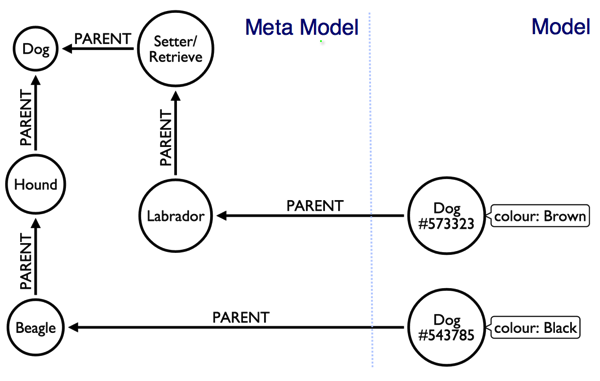Neo4j: Modelling sub types
A question which sometimes comes up when discussing graph data modelling is how you go about modelling sub/super types.
In my experience there are two reasons why we might want to do this:
-
To ensure that certain properties exist on bits of data
-
To write drill down queries based on those types
At the moment the former isn’t built into Neo4j and you’d only be able to achieve it by wiring up some code in a pre commit hook of a transaction event handler so we’ll focus on the latter.
The typical example used for showing how to design sub types is the animal kingdom and I managed to find a data set from Louiseville, Kentucky’s Animal Services which we can use.
In this case the sub types are used to represent the type of animal, breed group and breed. We then also have 'real data' in terms of actual dogs under the care of animal services.
We effectively end up with two graphs in one - a model and a meta model:

The cypher query to create this graph looks like this:
LOAD CSV WITH HEADERS FROM "file:/Users/markneedham/projects/neo4j-subtypes/data/dogs.csv" AS line
MERGE (animalType:AnimalType {name: "Dog"})
MERGE (breedGroup:BreedGroup {name: line.BreedGroup})
MERGE (breed:Breed {name: line.PrimaryBreed})
MERGE (animal:Animal {id: line.TagIdentity, primaryColour: line.PrimaryColour, size: line.Size})
MERGE (animalType)<-[:PARENT]-(breedGroup)
MERGE (breedGroup)<-[:PARENT]-(breed)
MERGE (breed)<-[:PARENT]-(animal)We could then write a simple query to find out how many dogs we have:
MATCH (animalType:AnimalType)<-[:PARENT*]-(animal)
RETURN animalType, COUNT(*) AS animals
ORDER BY animals DESC==> +--------------------------------+
==> | animalType | animals |
==> +--------------------------------+
==> | Node[89]{name:"Dog"} | 131 |
==> +--------------------------------+
==> 1 rowOr we could write a slightly more complex query to find the number of animals at each level of our type hierarchy:
MATCH path = (animalType:AnimalType)<-[:PARENT]-(breedGroup)<-[:PARENT*]-(animal)
RETURN [node IN nodes(path) | node.name][..-1] AS breed, COUNT(*) AS animals
ORDER BY animals DESC
LIMIT 5==> +-----------------------------------------------------+
==> | breed | animals |
==> +-----------------------------------------------------+
==> | ["Dog","SETTER/RETRIEVE","LABRADOR RETR"] | 15 |
==> | ["Dog","SETTER/RETRIEVE","GOLDEN RETR"] | 13 |
==> | ["Dog","POODLE","POODLE MIN"] | 10 |
==> | ["Dog","TERRIER","MIN PINSCHER"] | 9 |
==> | ["Dog","SHEPHERD","WELSH CORGI CAR"] | 6 |
==> +-----------------------------------------------------+
==> 5 rowsWe might then decide to add an exercise sub graph which indicates how much exercise each type of dog requires:
MATCH (breedGroup:BreedGroup)
WHERE breedGroup.name IN ["SETTER/RETRIEVE", "POODLE"]
MERGE (exercise:Exercise {type: "2 hours hard exercise"})
MERGE (exercise)<-[:REQUIRES_EXERCISE]-(breedGroup);MATCH (breedGroup:BreedGroup)
WHERE breedGroup.name IN ["TERRIER", "SHEPHERD"]
MERGE (exercise:Exercise {type: "1 hour gentle exercise"})
MERGE (exercise)<-[:REQUIRES_EXERCISE]-(breedGroup);We could then query that to find out which dogs need to come out for 2 hours of hard exercise:
MATCH (exercise:Exercise {type: "2 hours hard exercise"})<-[:REQUIRES_EXERCISE]-()<-[:PARENT*]-(dog)
WHERE NOT (dog)<-[:PARENT]-()
RETURN dog
LIMIT 10==> +-----------------------------------------------------------+
==> | dog |
==> +-----------------------------------------------------------+
==> | Node[541]{id:"664427",primaryColour:"BLACK",size:"SMALL"} |
==> | Node[542]{id:"543787",primaryColour:"BLACK",size:"SMALL"} |
==> | Node[543]{id:"584021",primaryColour:"BLACK",size:"SMALL"} |
==> | Node[544]{id:"584022",primaryColour:"BLACK",size:"SMALL"} |
==> | Node[545]{id:"664430",primaryColour:"BLACK",size:"SMALL"} |
==> | Node[546]{id:"535176",primaryColour:"BLACK",size:"SMALL"} |
==> | Node[567]{id:"613557",primaryColour:"WHITE",size:"SMALL"} |
==> | Node[568]{id:"531376",primaryColour:"WHITE",size:"SMALL"} |
==> | Node[569]{id:"613567",primaryColour:"WHITE",size:"SMALL"} |
==> | Node[570]{id:"531379",primaryColour:"WHITE",size:"SMALL"} |
==> +-----------------------------------------------------------+
==> 10 rowsIn this query we ensured that we only returned dogs rather than breeds by checking that there was no incoming PARENT relationship. Alternatively we could have filtered on the Animal label...
MATCH (exercise:Exercise {type: "2 hours hard exercise"})<-[:REQUIRES_EXERCISE]-()<-[:PARENT*]-(dog:Animal)
RETURN dog
LIMIT 10or if we wanted to only take the dogs out for exercise perhaps we’d have Dog label on the appropriate nodes.
People are often curious why labels don’t have super/sub types between them but I tend to use labels for simple categorisation - anything more complicated and we may as well use the built in power of the graph model!
The code is on github should you wish to play with it.
About the author
I'm currently working on short form content at ClickHouse. I publish short 5 minute videos showing how to solve data problems on YouTube @LearnDataWithMark. I previously worked on graph analytics at Neo4j, where I also co-authored the O'Reilly Graph Algorithms Book with Amy Hodler.
